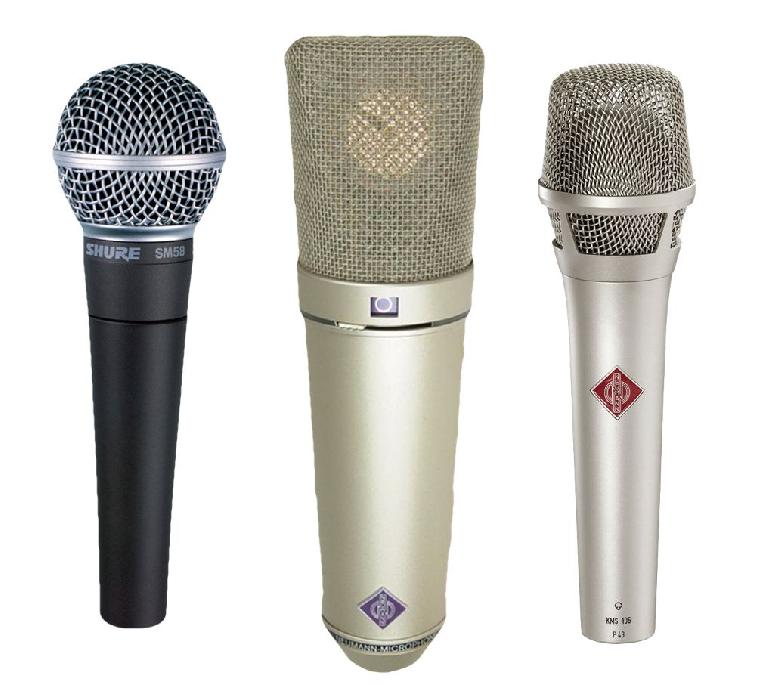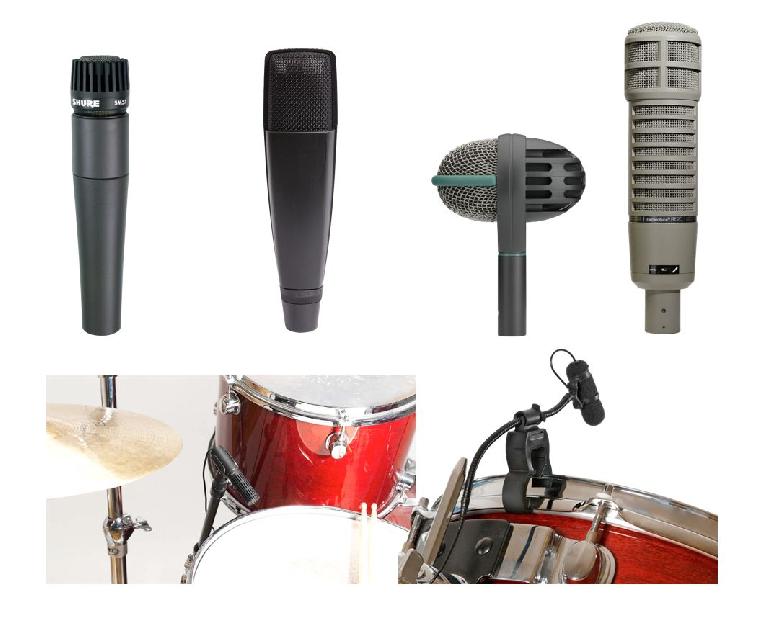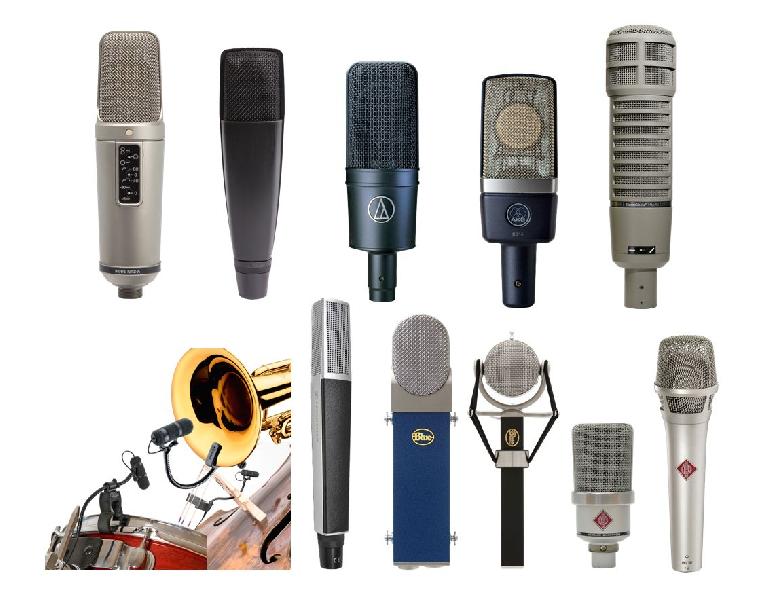A miking question that often comes up for both studio and stage applications is “should I use a dynamic or a condenser mic?” There’s plenty of advice floating around about the best options for various applications, so it might be a good idea to take a look at some of those standard recommendations in a little more detail. Here are five examples of the conventional wisdom regarding dynamics and condensers—let’s see how they hold up.
1. Dynamics are better for stage use
I wouldn’t say that this is wrong, but, then again, I wouldn’t say that it’s right, either. There are reasons why you might choose to use dynamic mics on stage (at least on some stages), and condensers probably are more widely employed in the studio, but there’s nothing inherently better or worse about either type, for stage applications. The reasoning behind this suggestion brings several assumptions to the table:
1A) Dynamics are better for stage use because they can take a hit:
Everybody’s seen a (dynamic Shure) SM58 go flying, hit the floor, and come up dented but still working. On the other hand, I’ve seen a (condenser Neumann) U87 hit the floor once and stay down for the count. But those are two extremes, and you can’t draw too broad a conclusion from that—there are many robust condenser mics that can easily stand up to the rigors of a live show. Just because most small clubs have a mic closet stuffed with nothing but beat-up Shure SM57s and 58s (the standard dynamic instrument & vocal mic, respectively), doesn’t mean that in other venues, you won’t find condensers as well. Many jazz clubs use condensers for piano and drum overheads, and some handheld condenser mics specifically designed for vocals (and solo instruments), like the Neumann KMS 105, have become the new standards in those locales. Certainly, you wouldn’t want to set up a delicate studio condenser on a small stage, but the right condenser will be just as at home there as the more typical dynamic choices.
1B) Dynamics are better for stage use because Condensers feedback too easily:
This is another half-truth. I have seen a singer bring their own personal condenser mic, have the engineer plug it into the board, and immediately get feedback. But that’s not because it’s a condenser. It may be because the engineer didn’t readjust his settings for a possibly higher output, or reposition a (monitor) wedge for the new mic’s different response pattern. Of course, some more studio-oriented condensers may in fact have wider patterns that would be more prone to feedback live, but if a more appropriate stage condenser is chosen, everything should be fine—if the system is set up properly, a condenser should have no more problems with feedback than a dynamic.
1C) Dynamics are better for stage use because Condensers require external power:
Well, unless the club has a circa-1950s Heathkit or Bogen PA, even the smallest live boards usually have Phantom Power built in—you just have to turn it on. Anyone who worries about this—well, they shouldn’t!
2. In the studio, Dynamics are for drums & amps, Condensers are for everything else
Now, this is often (OK, usually) what you see, so it’s not surprising that many people adhere to this as a rule set in stone. You certainly won’t go wrong with the traditional drum kit close mic choices of SM57 on snare, Sennheiser 421’s on toms (and sometimes kick), and AKG D112 or EV RE-20 on kick (all dynamics). But, in fact, condensers are often used around the drum kit, and not just for hihat & overheads. One of the most common scenarios is the use of miniature condensers, like the many excellent options from companies like DPA, as close mics around the kit—in fact, with their small size and low visual impact (virtually invisible from the audience), they’re also popular—and a good choice—for live drum miking as well.
On the other hand, sometimes, even in a case where a condenser would usually be the obvious choice, a dynamic might have some advantages.
3. Condensers are better in the studio because they’re more accurate (have a flatter response)
Well, another half-truth, sort of… Condenser mics do, in fact, often have better transient response and an extended frequency response, in comparison with some dynamic mics, and so they may provide a more open detailed sound. But once again, it’s not a universal truth that they’re automatically “better” in every case. First off, as most studio engineers know, many condensers—especially the large-diaphragm condensers favored for vocals—are anything but flat, with a broad rise in the upper mids and treble (around 5–6k to 10k or so)—this is often a major factor in that open, detailed condenser sound, that floats so well above the mix, even without EQ. But there are many dynamics with a wide, flat frequency response—the RE-20 comes to mind—that could easily take the place of a condenser. In fact, sometimes that quick transient response and broad high-frequency emphasis of so many condensers can react less-than-ideally to very bright instruments, like certain jangly percussion, and a slightly more subdued dynamic mic might tame the instrument more successfully. With instruments like trumpet and trombone, that beam their bright sound straight at the mic, dynamics are often chosen for a smoother sound (so are ribbons, for their even greater warmth, but that’s another article). To make a long story short, a top-notch dynamic mic can often do just as good a job on plenty of things besides drums & amps—if you choose the best dynamic mic for the job at hand.
4. Dynamics are for louder instruments, because Condensers are more delicate
I touched on this idea of condensers as “delicate” earlier—some condensers are more prone to damage from mishaps like a fall, or an errant drumstick, but that’s not really the issue here. People often assume, because of this reputation for delicacy, that louder sounds will damage the mic itself—the diaphragm. This concern may come from reading stories about how engineers at Abbey Road, in the old (pre-Beatles) days, would be fined for positioning one of the studio’s pricey condenser mics too close to a kick drum, or some other loud source. But most modern condensers are capable of handling very high SPLs, making them suitable for close-miking tasks—even things like kick drum, which many engineers like to capture with a condenser. Once again, you have to know your models—some vintage condensers should be treated with a bit more care, but in many other cases, condensers can hold up to a lot of level, and come away smiling.
5. Dynamics are for people on a budget
Finally, there’s the general impression that dynamics are the mics of the people—affordable by the masses of struggling, starving musicians and small studio guys—while condensers are up in the stratosphere, price-wise—only attainable by big-ticket studios and rich rock stars. Of course, like with all the conventional wisdom I’ve been having a go at here, there’s some truth to this—you will find plenty of sub-$100 dynamics mics, and if you see a mic for $3000–4000 (or much higher, in the case of vintage units), it’s almost certainly a condenser. But in the broad area in-between, nowadays good dynamics and condensers can be had at all price points, with the $300/500–$700/1000 range especially chock-full of both types, providing top-quality (exceeded only by the subtle extra character of those really hi-end models, and the extra warmth of actual vintage mics).
In the lower range ($300–400) of that temperate zone, you’ll find good mics of both types ( [D] & [C] ) from companies like Rode (NT-2A [C]), Sennheiser (421 [D]), Audio-Technica (4033 [C]), AKG (214 [C]), and EV (RE-20 [D]). Still under a grand, there are even more high-end choices—DPA (various miniature-[C]’s), Blue (Blueberry, Dragonfly [C]), Sennheiser (441 [D]), and Neumann (TLM 102 [C] & KMS 105 [C for live use]).
But you’ll even find budget condensers in the sub-$100 range, along with dynamic standards like the (Shure) SM 57 & 58, and they perform quite well—far better than you’d have a right to expect, given the cost. So there’s no excuse for not ferreting out the right type of mic, no matter how limited the budget—in fact, with the low $ bar for decent entry-level mics nowadays, there’s no reason for even the smallest studios not to have at least one of each.
The Wrap
So, what about all that conventional wisdom regarding Dynamic and Condenser mics? Well, there’s some truth to most of it, as long as you continue to read below the headline. But there are also a lot of half-truths and outmoded concerns, so it pays to dig a little deeper when it comes to choosing dynamic or condenser—armed with the bigger picture, you should be able to make a much more informed choice.
Want to understand more about recording audio, from microphone placement and usage for vocals, guitars, bass, drums and more? Watch these excellent video courses in The AskAudio Academy.





 © 2024 Ask.Audio
A NonLinear Educating Company
© 2024 Ask.Audio
A NonLinear Educating Company
Discussion
Want to join the discussion?
Create an account or login to get started!